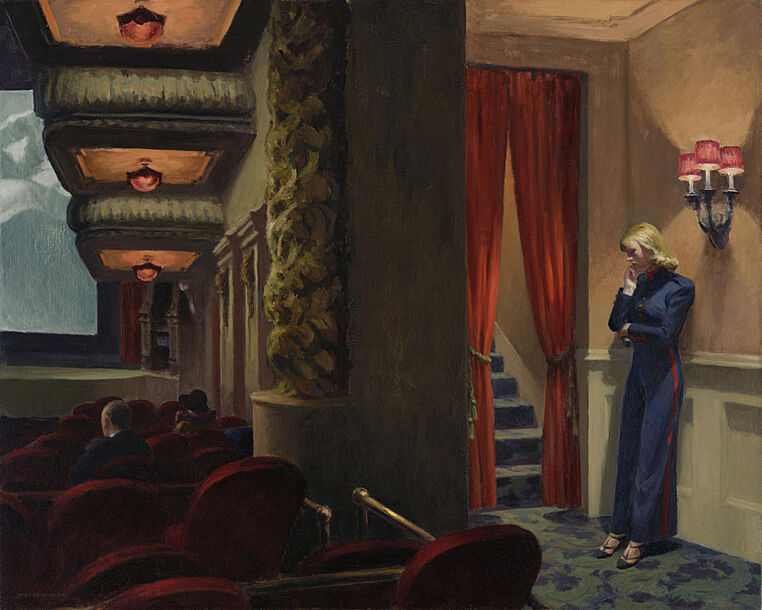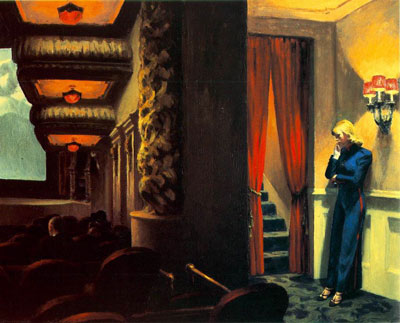edward hopper new york movie
He visited numerous movie theatres (including the Republican, Globe and Strand), sketching the picturesque interiors and fascinating characters.
The painting inspired American Poet Joseph Stanton to write a poetic ode to the painting entitled “Edward Hopper’s New York Movie”.
A movie theater in New York, one of those elaborate mock palaces where Hollywood spirits us for a few hours into another world – in this case apparently the high mountains. Spirits us as audience, that is, but not the usher, who has probably seen the movie a thousand times and waits for the curtain, mulling over her own thoughts. Her stationary figure counterpoints the screen with its incessantly flickering illusions of places not here and not now.
Like most of the female figures in Hopper’s paintings, this one was based on his wife, Jo, who posed standing under a lamp in the hall of their apartment. As the many preliminary studies for the picture show, Hopper not only drew his wife in various different poses for New York Movie, but precisely designed the auditorium decor, down to the pattern of the carpet. Again and again he sketched the foyers, stairways, and auditoriums of his favorite movie houses, the Palace, Globe, Republic, and Strand.

Edward Hopper, New York Movie, 1939
Edward Hopper, New York Movie, 1939. Oil on canvas, 32 1/4 × 40 1/8 in. (81.9 × 101.9 cm). The Museum of Modern Art, New York; given anonymously 396.1941. Digital Image © The Museum of Modern Art/Licensed by SCALA / Art Resource, NY

Ask any film buff about Hopper’s influence on film noir and they will likely start talking about Nighthawks. Bring up film in general and they will mention New York Movie. Hopper was an ardent filmgoer. At the time of the painting, while there had been only intimations of noir like 1940’s The Stranger on the Third Floor (where someone is murdered in a diner), Hopper had seen and absorbed gangster flicks like Scarface (1932), Public Enemy (1930), Little Caesar (1931), and Bullets or Ballots (1936). Meanwhile he’d also discovered an appealing subject in moviehouse interiors like the one in New York Movie, which Hopper researched by taking his sketchbook to Times Square theatres like the Globe, Republic, Strand, and his primary model the Palace. Before it was finished, New York Movie required 54 drawings, more than any other painting in his career.
Nighthawks has to be seen in person to be truly appreciated. Of course this is true of just about any accomplished work of art, but the only way to comprehend the magnitude of this painting is to stand in front of it. You can see Nighthawks, along with other key works like New York Movie (1939) and Office at Night (1940), in the Whitney Museum’s “Hopper Drawing,” which is billed as “the first major museum exhibition to focus on the drawings and creative process of Edward Hopper.” Organized by curator of drawings Carter Foster, the exhibit will be on view through October 6.

A solid end-wall with an ornate leafy column separates the star of the show (an usherette) from the show of the stars (the movie). Two horizontal brass hand-rails complete the critical division between the subdued but luxuriant glow of fantasy land and the harsh glare of the real world. On the left, three glass lanterns suspended in echelon from the lofty ceiling cast a soft light over plush red velvet seats, where a solitary man and woman ambiguously occupy separate rows in a dark, empty, cavernous auditorium. They stare featureless at the large black and white cinema screen. She wears a floppy wide-brimmed hat and a fur-collared coat, while he is bare-headed but neatly trimmed and suited, his white shirt collar conspicuous in the gloom. On the right the unforgiving lumens from a triple candlestick wall-light (complete with pink shades) capture the pensive form of a tall, beautifully coiffured young woman, stylishly tailored in a military-styled uniform. The smart royal-blue suit has brass buttons, epaulettes, red stripes down wide bottom trousers and complementary red flashes on the cuffs and collar. A pair of black, strappy, high-heel sandals completes the ensemble. Her face is clouded, her eyes closed; she seems deep in thought, her chin resting on her right hand, supported by her left, which clutches a torch (flashlight). She rests her back resignedly against the dado rail of the half-panelled wall behind her. In front, tied-back burnt-orange curtains reveal grey-blue carpeted stairs, which lead up and out of the cinema into the threatening world beyond. The grisaille vignette on the cinema screen displays snowy Himalayan peaks from Frank Capra’s 1937 blockbuster movie Lost Horizon [1], a story about Shangri-la—a lost sanctuary of peace and safety [2]. Yet the usherette chooses not to watch the film. It provides her with no escape from the theatrum mundi.
Mike McKiernan, Edward Hopper, New York Movie 1939, Occupational Medicine, Volume 67, Issue 3, 1 April 2017, Pages 174–175, https://doi.org/10.1093/occmed/kqx024

For a 20th Century painter he was, however, remarkably traditional in his approach – his work featuring the kind of realism of a Manet or Renoir, only without the charm or comfort factor. In addition to his famous city-scapes, he also painted some iconic outdoor scenes of the North-East US, though again often stark and empty in nature.
The scene has, on the face of it, a fairly obvious narrative: The interior of a movie theatre sometime in the first half of the 20th Century; the lighting subdued; people watching the screen; and an usherette, idle, deep in thought – perhaps a little sad by the looks of it. So … what’s to get excited about?
![]()
Edward Hopper’s painting, “New York Movie” (1939) offers another wonderfully honest glimpse of life as it happens, the “space between the notes” if you will. The setting is a New York movie theater as we view the theater attendant leaning against the wall in the vestibule of the theater under Hopper’s magnificent lighting contrasted by the other half of the painting which features the scene within the theater as a couple of seated patrons watch the movie. To me, the theater attendant is the star as Hopper captures yet another overlooked unassuming moment. Is she bored? Is she listening in to the movie? Is she simply waiting for the movie to end? What is she thinking about? I’ll leave it to you to decide.
COMPOSER’S NOTES: In full disclosure, this is quite possibly my favorite painting of all time from my favorite painter of all time, Edward Hopper. I was so excited to finally experience it in person a couple of years ago during the Art Institute of Chicago’s “America After the Fall – Painting in the 1930s” exhibit where the painting was on loan from the New York Museum of Modern Art, it’s current home. The piece begins with purposeful distance from the magic unfolding on the movie screen with a monotonous musical phrase to reflect the moment taking place away from the screen leading toward the presentation of the theater attendant using a variation on the phrase to reflect her thoughts. Slowly the piece moves from the mundane toward the magic taking place on the screen with a more emotive passage which winds its way back to the beautifully mundane scene of the theater attendant.
References:
http://www.edwardhopper.net/newyork-movie.jsp
http://whitney.org/WatchAndListen/951
http://www.towntopics.com/wordpress/2013/08/28/nighthawks-usherettes-and-shapely-secretaries-a-new-york-movie-by-edward-hopper/
http://academic.oup.com/occmed/article/67/3/174/3095958
http://robertstephenparry.com/endymion/thoughts-on-usherette.html
http://m.youtube.com/watch?v=L_BQcRQYZaA
http://www.edwardhopper.net/nighthawks.jsp
